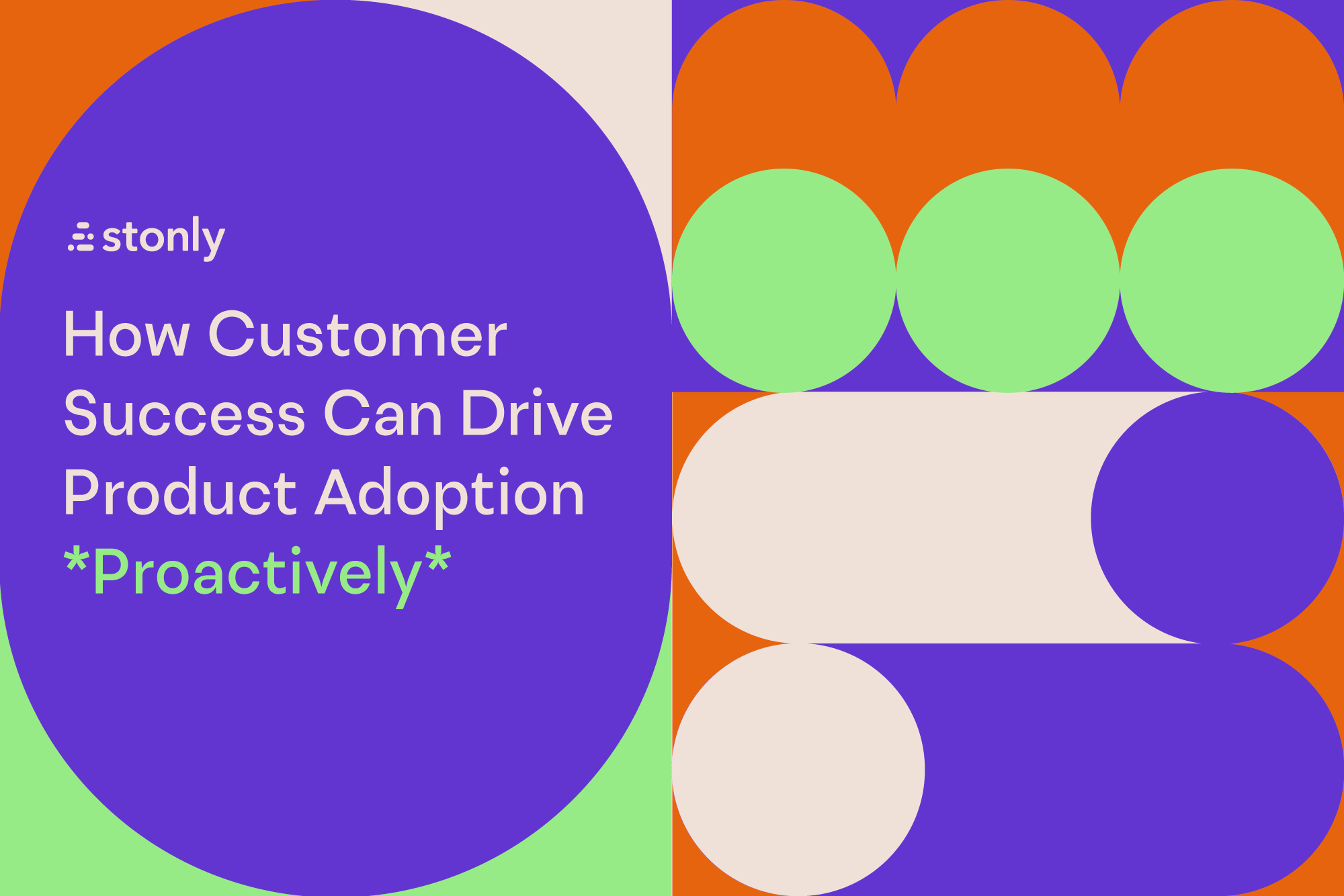The best customer success strategy positions your CSMs as trusted advisors. You want your customers to see your CSMs as more than product experts or another customer service team.
Ideally, customers should view your CSMs as strategic partners for their businesses. A trusted advisor that your customer can rely on to help them accomplish their business goals.
Customer success is fundamentally about building customer loyalty. There’s clear business value in improving your customer retention rates, including significant increases in profitability. But if you want to create the kind of loyalty that goes beyond a single purchase and turns your customers into advocates, you need to develop a different type of relationship with them.
That’s very easy to say. It’s much harder to do.
The typical struggle for CSMs: Being too reactive
Many customer success teams fall into the trap of defaulting to being another support team.
Whereas your support team serves all your customers, customer success managers often turn into white-glove support for the specific customers they serve. There’s an easy way to test if this has happened to your CSMs:
Do your customers only reach out when they have a specific issue they want to be resolved? If so, your customers probably view your CSMs as a reactive support channel.
That isn’t a problem in and of itself. White-glove support has a role to play in customer success. The problem is that it often happens at the expense of other tasks that provide more value to customers. It happens because companies haven’t developed their customer success strategy. And it’s a common problem because research shows that as many as 37% of companies don’t have a clearly-defined customer success strategy.
It all comes down to this question: How can you leverage your customer success team in the most impactful way?
Related Article: 4 Big Wins to Increase Your Customer Success Team’s Impact
Positioning CSMs as trusted advisors
Being a trusted advisor is difficult to achieve. Taking trust builds time. The only way your CSMs can become trusted advisors is by working step-by-step on building long-lasting relationships with their customers. Every interaction they have with a customer—small or large—moves them closer or further from being a trusted advisor.
Here are five ways you can develop your customer success strategy to enable CSMs to function as trusted advisors:
- Understand your customers’ industry and market
- Create tailored success plans for each customer
- Focus your calls on customer needs
- Develop the role of white-glove support in your customer success strategy
- Reduce the demand for white-glove support
1. Understand your customers’ industry and market
Customer success is about helping customers achieve their goals. Those goals are set within your customers’ broader industry context and market.
The biggest prerequisite to becoming trusted advisors is understanding your customers’ industry. It’s hard or impossible for your CSMs to give valuable advice when they haven’t developed industry expertise. While anyone might be able to fake expertise for a while, a lack of knowledge eventually becomes obvious. If your CSMs can only share generic insights, they will not be a valuable resource for their customers.
Your customer base is probably diverse. This doesn’t mean you should invest in having each CSM develop specialized knowledge in every industry possible. It just means that your CSMs should be able to follow and contribute meaningfully to a conversation about the customer’s business, the current state of their industry, and the reasons behind the goals they set.
Knowing your customers’ needs and context is the foundation for establishing trust-filled relationships.
2. Create tailored success plans for each customer
If you aren’t already creating customized customer success plans for each customer, you should start today.
Seriously. Working on a joint success plan with a customer is the best way to answer critical questions about their needs and opportunities. It should be an integral part of your customer success strategy. Start with questions like these:
- What do they want to achieve?
- What problem is your product or service solving?
- What does success look like for them?
- What are their biggest challenges?
The success plan should form the basis of all communication with that customer from that point onwards.
You can use it to enhance email communications and make them more meaningful and valuable. It should help you understand which product features are most relevant to a customer. If you want to increase feature adoption, you can tie recommendations to the specific goals the customer wants to achieve.
The more personalized your success plan (and your communication) is, the more likely customers will start seeing CSMs as trusted advisors.

3. Focus your calls on customer needs
Every customer call allows your CSMs to understand your customers’ needs better. The focus of every call should be the customer, what they want to achieve, and their experience with your product. Ideally, your customer should walk away from each conversation with the impression that you care about making their business successful.
“Being a trusted advisor starts with empathy (listening and validation) and credibility (not product expertise).”
~Carly Agar, customer success enablement manager at Heap.
It’ll always be tempting for your CSMs to focus on selling your product or service. Even if they aren’t selling, they’ll still be tempted to spend most of their time with customers explaining how your product works, providing workarounds, or sharing new developments. These things are easy to become experts in.
Your CSMs should know and talk about your product, but it’s far more impactful when they can do that in a contextual and timely way for each specific customer. You don’t just want customers to know information about your product. You want customers to understand precisely how your product can help them accomplish their end goal.
It’s about your customer, not you.
In practice, this means being honest about the potential shortcomings of your product if your customer wants something your product is incapable of providing. It means being upfront if your customer has a feature request you know will never happen.
Imagine you’re visiting a doctor. During your visit, all they do is talk about the upgrades to their examination rooms and the latest medical technology advancements. They brag about a new trial medicine they’re approved to prescribe. When you start talking about your symptoms, they quickly gloss over details or give you generic answers.
Sounds like an awful doctor appointment, doesn’t it? We all expect doctors to be empathetic and to take the time to listen to our unique symptoms and circumstances. To ask good questions so that they fully understand what we’re experiencing. To care about our wellbeing.
Your customers have the same expectations of your customer success managers.
4. Develop the role of white-glove support in your customer success strategy
95% of customers say that customer service is essential to brand loyalty, according to Microsoft Dynamics’ State of global customer service report. Consciously providing white-glove support is a way many companies have tried to capitalize on this expectation.
Companies often target high-value customers and offer them a premium, highly-personalized support experience. People argue about whether this type of experience should sit within a customer success team’s responsibilities. Some people argue that a customer support team should handle all reactive support needs, freeing up the customer success team to focus elsewhere.
The challenge with this argument is that many customers will naturally reach out to their CSM when they have a problem. If they’ve developed a relationship with their CSM, it’s natural that they’d prefer to ask them directly.
Deflecting customers who ask direct questions and struggle with your product is probably not the best experience. This is why some argue that white-glove support is essential to customer success.
Related Podcast: Building a High-Velocity Customer Success Program
You’ll need to decide whether it makes the most sense for white-glove support to live with your support or success team. Primary questions to consider include:
- How much time are your CSMs spending on providing reactive support?
- What’s the impact of the time your team is spending on this?
- Is your support team equipped to deliver personalized support to important customers?
5. Reduce the demand for white-glove support
In most cases, reducing the demand for white-glove support is a good decision for your customer success team and your business.
Using a tool like Stonly makes it easy to automate support interactions without deflecting customers and creating a poor experience. As customers contact CSMs with support problems, you can build interactive guides and tours to help them solve them automatically.

Automation should be about making self-service effortless and accessible for customers. You want to make your self-help option so easy and satisfying that it becomes your customers’ preferred way to find help. This approach eliminates the risk of giving customers the impression that you’re trying to push them off or make it harder for them to reach you.
The biggest challenge with white-glove support is that it’s hard to scale any personalized experience. It almost seems like a contradiction: how can something be personalized yet scaled to the masses? But if it’s valuable for your customers and your business, you’d do well to make it available for everyone.
Stonly solves this problem in three ways:
- Making help contextual. You can tailor in-app walkthroughs and in-app help to the customer and their needs, rather than being forced to serve them with a static knowledge base. Support and knowledge become contextual and available right where your customers need them.
- Preventing issues before they happen. When you know where your customers get stuck, you can preemptively tackle these as part of your onboarding process. You can get ahead of issues across your entire customer base.
- Enabling a proactive approach. You can proactively reach out to a subset of customers with tailored help when something impacts them, rather than waiting for them to get in touch with you. Every CSM can easily communicate with as many customers as needed.

A customer success strategy that delivers results
Customer success should be a transformative part of your business. It all starts with a sound strategy. Building a great customer success strategy begins with segmenting your customers and tailoring the experience you want to provide across every stage of the customer journey.
Enabling your CSMs to be trusted advisors is the key to creating deep and meaningful relationships with your customers. Your CSMs become partners that help your customers see results.
And as you help your customers achieve their goals, you’ll also drive success for your business.
Provide personalized, contextual in-app guidance exactly when and where your customer is ready. See how by scheduling a Stonly demo today.

